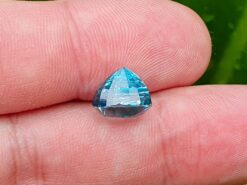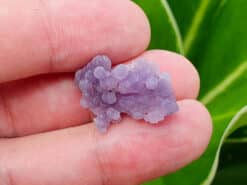Microcline

Microcline (KAlSi3O8) is an important igneous rock-forming tectosilicate mineral. It is a potassium-rich alkali feldspar.
Buy natural gemstones in our shop
It typically contains minor amounts of sodium. It is common in granite and pegmatites. It forms during slow cooling of orthoclase, it is more stable at lower temperatures than orthoclase. Sanidine is a polymorph of alkali feldspar stable at yet higher temperature.
It may be clear, white, pale-yellow, brick-red, or green, it is generally characterized by cross-hatch twinning that forms as a result of the transformation of monoclinic orthoclase into triclinic microcline.
The chemical compound name is potassium aluminium silicate.
Geology
The stone may be chemically the same as monoclinic orthoclase, but because it belongs to the triclinic crystal system, the prism angle is slightly less than right angles, hence the name “microcline” from the Greek “small slope.”
It is a fully ordered triclinic modification of potassium feldspar and is dimorphous with orthoclase. It is identical to orthoclase in many physical properties, it can be distinguished by x-ray or optical examination, viewed under a polarizing microscope, It exhibits a minute multiple twinning which forms a grating-like structure that is unmistakable.
Perthite is either microcline or orthoclase with thin lamellae of exsolved albite.
Amazon stone, or amazonite, is a green variety of microcline. It is not found anywhere in the Amazon Basin, however. The Spanish explorers who named it apparently confused it with another green mineral from that region.
The largest documented single crystals were found in Devils Hole Beryl Mine, Colorado, US and measured 50 x 36 x 14 m. This could be one of the largest crystals of any material found so far.
It is commonly used for the manufacturing of porcelain.
- Crystal system: Triclinic
- Category: Tectosilicate
- Pleochroism: No
- Habit/Shape: Can be anhedral or euhedral. Grains are commonly elongate with a tabular appearance. May contain lamellae which formed from exsolved albite.
- Relief: Low negative relief
- Cleavage/Fracture Habit: Has perfect cleavage parallel to {001} and good cleavage on {010}. Cleavages intersect at 90°41′. It can be difficult to see cleavage in thin section due to microcline’s low relief.
- Twinning: Typically displays albite twinning and pericline twinning. This combination leads to a grid pattern, hence microcline displays gridiron twinning. Can also display carlsbad twinning, simple twins, or lack twinning altogether. Lamellae in microcline are discontinuous and “pinch and swell.”
- Refractive Index: nα = 1.514 – 1.529 nβ = 1.518 – 1.533 nγ = 1.521 – 1.539
- Specific Gravity: 2.5 2.6
- Birefringence: Up to first order white (roughly 0.007)
- Extinction Habit/Angle: Inclined extinction to cleavage
- Composition: K(AlSi3O8)
- Tenacity: Brittle
- Optic Sign: Biaxial negative
- Transparency: Bransparent, Translucent
- Alteration: Commonly alters to sericite or clay.
- Color: White, grey, greyish yellow, yellowish, tan, salmon-pink, bluish green, green.
- Luster: Vitreous
- Mohs Scale (hardness): 6 – 6.5
- Distinguishing Characteristics: Gridiron twinning distinguishes microcline from other feldspars. Distinguishable from plagioclase because the lamellae in plagioclase are continuous and do not “pinch and swell.”
Sample from Myanmar
FAQ
What does microcline do spiritually?
Metaphysical practitioners believe that microcline stimulates clarity of thought, enhances general understanding, and improves one’s ability to cooperate with others. Microcline is mined for use in the manufacture of glass and ceramics.
Is microcline a Kspar?
Plagioclase feldspars lack potassium, are light colored and are usually striated. The other k-spar minerals are sanidine, microcline and anorthoclase. Orthoclase is the more common of the k-spars.
What rock has microcline?
Microcline is a major rock-forming mineral in many rocks, especially granite, syenite, pegmatite, and metamorphic gneisses. Microcline is commonly found together with feldspar in granite, syenite, and pegmatites, critically characterzing acidic and neutral core igneous rocks.
















